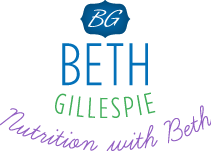The hot topic these days in the field of nutrition is how to best take care of our mitochondria, the little but mighty powerhouses in our cells that create energy! I attended the National Association of Nutrition Professionals conference last month and listened to a great lecture by Dr. Robert Rountree. I am sharing with you some important take aways from his talk and steps you can take to care for YOUR mitochondria!
Why is this important? Because the most prominent roles of mitochondria are to produce the energy currency of the cell, ATP! We need ATP for all of our chemical reactions in the body. And the more ATP we have, the better we function and the more energy we have! Mitochondrial dysfunction has been tied to all types of diseases as well as accelerated aging. And who wants that?
What are some basic steps to reverse mitochondrial dysfunction?
- Decrease excess free radical exposure by avoiding or limiting alcohol, damaged fats ( i.e. fried foods), refined sugars including high fructose corn syrup, excess calories, and by reducing stress.
- Identify and treat sources of inflammation. Inflammation is caused by repeated injuries, poor diet, food allergies, a sedentary lifestyle, over-training, and chronic infections (like gum disease for example). A nutritionist or holistic practitioner can help you with this step!
- Resolve digestive or other GI issues. It is Important to address your gut issues now to decrease inflammation and prevent further damage to your mitochondria. A nutritionist can definitely help you if you have digestive issues.
- Remove environmental toxic exposures. Please refer to my previous blog for simple steps to reduce daily environmental toxins.
Simple dietary steps to support your mitochondria:
- Minimize processed sugar, refined carbs, and high fructose corn syrup!
- Eat a wide range of colorful berries, veggies, spices and tea. The Farmers Markets are alive with colors right now!
- Increase beets and arugula which are rich in nitrates.
- Eat a liberal amounts of healthy fats like extra virgin olive oil, omega 3’s (found in wild salmon and other fatty fish, flaxseeds, etc) and coconut oil.
- If you do not have a blood sugar imbalance, try going 12 to 14 hours without eating. This helps to clean up the garbage in the cels. For example, eat dinner at 7:00 pm, and then eat a late breakfast at 9:00 am. If you are on the go in the morning, a protein smoothie will come in handy.
- Eat less, but go for nutrient dense when you do eat. In other words, make your calories count.
- And lastly, make sure that you are getting all the critical vitamins and minerals to support the making of energy via the Krebs cycle. Remember learning about the Krebs cycle in school? This is my favorite supplement to support the mitochondria and optimal energy levels: Mitochondrial NRG.
So how do you support mitochondrial biogenesis? The making of NEW mitochondria? Keep glucose and insulin levels low! So this means avoiding foods that spike your blood sugar like refined sugars, processed carbs, sweetened beverages, and excess tropical fruits. Next time you visit your physician, ask them to test for hemoglobin A1c. This is a test that measures glucose levels over a period of about three months. You want this number to be low!

